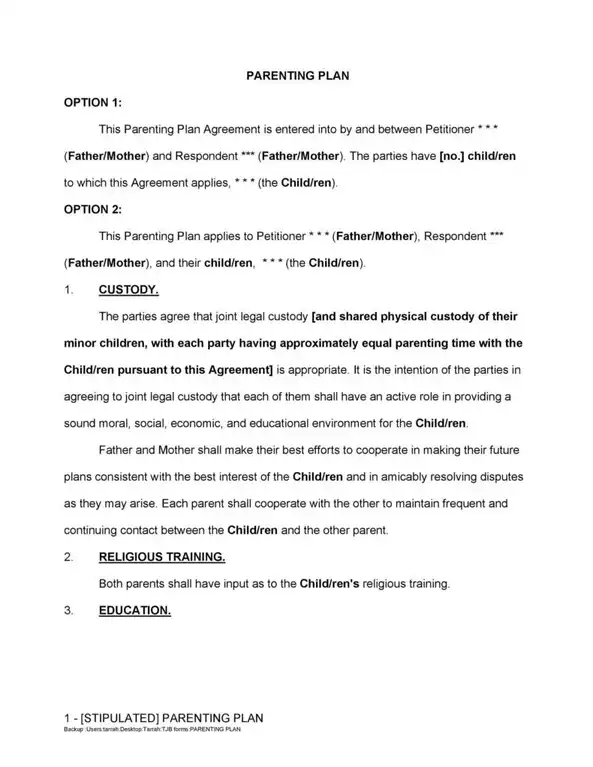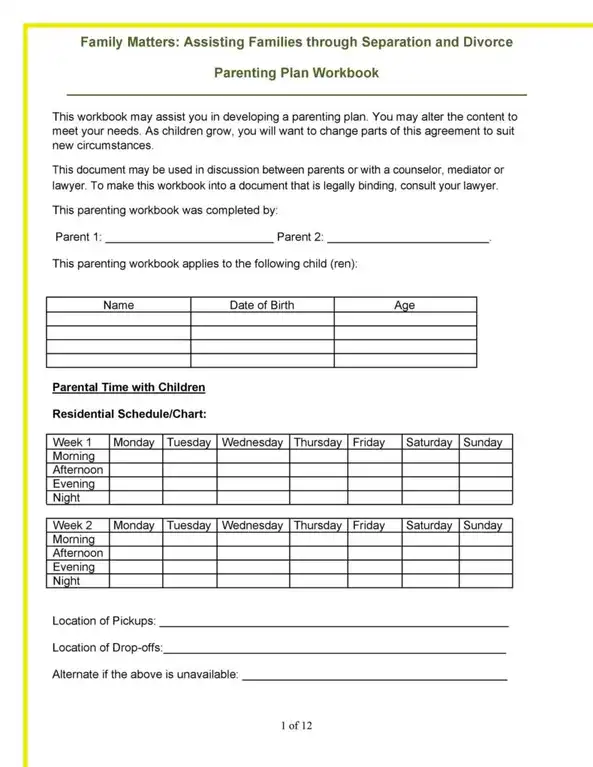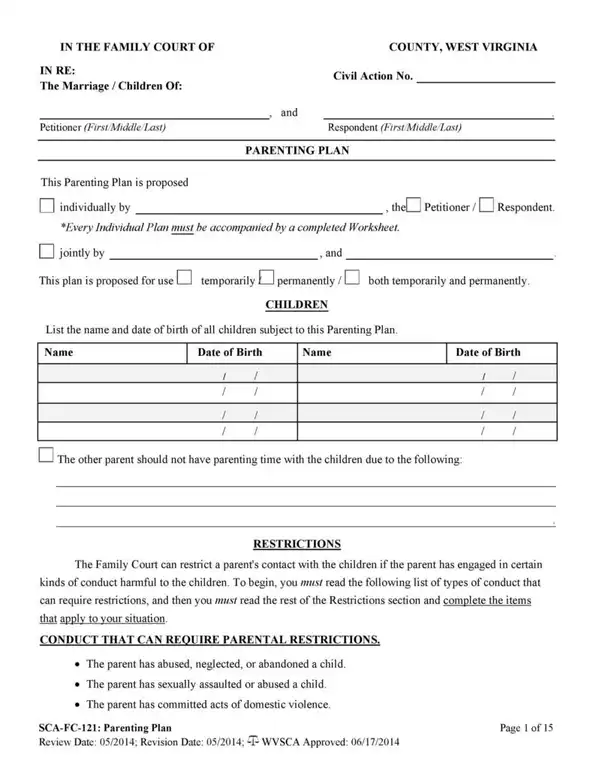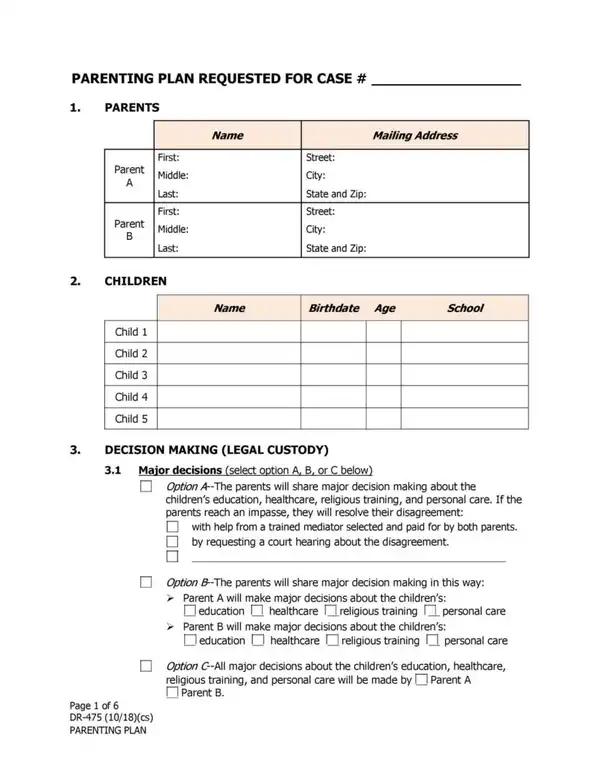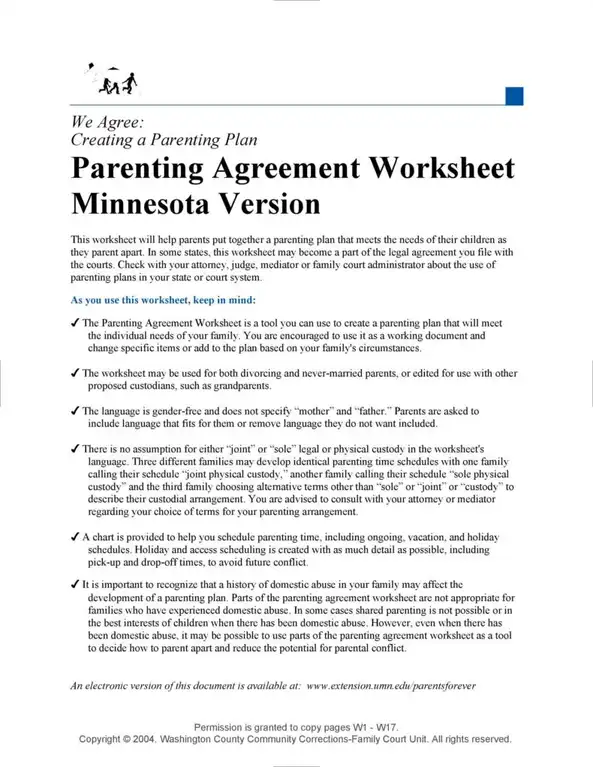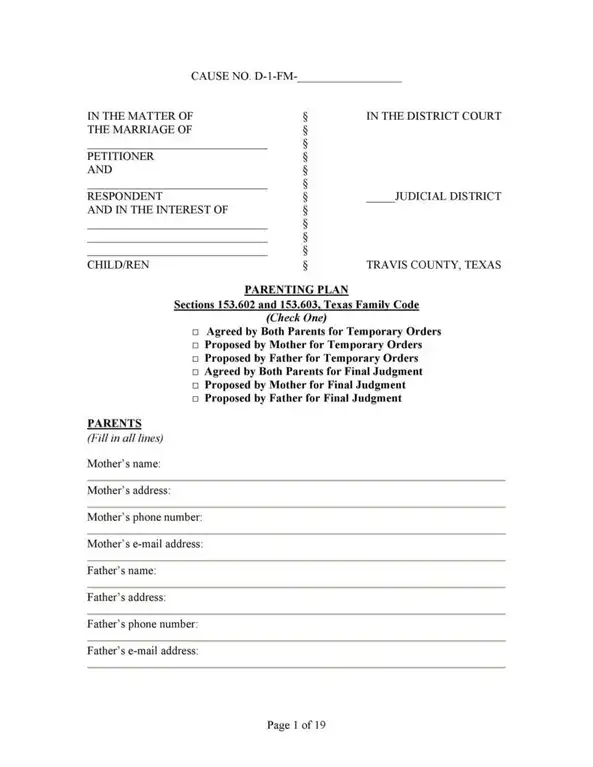A parenting plan agreement is an essential document for separated or divorced parents. It explains how they will care for their children. This plan helps both parents understand their roles and ensures they work jointly to build a stable and happy life for their children.
What is a Parenting Plan Agreement?
A parenting plan agreement is a special plan that helps parents manage their kids after separating or divorcing.
Example: Jake and Emily are divorced. Their parenting plan states that their son, Max, will live with Emily during the week and with Jake on weekends. The plan also states that both parents will decide together about Max’s school and health care.
Why is a Parenting Plan Important?
A parenting plan is important for many reasons:
Stability for the Child:
- Reason: It gives the child a clear routine. They know where they will be and when.
- Example: Max knows he will stay with Mom during the week and Dad on weekends.
Reduces Conflicts:
- Reason: It helps parents avoid arguments because everything is written down.
- Example: Jake and Emily don’t fight about pick-up times because it’s all in the plan.
Clear Communication:
- Reason: It sets rules for how parents discuss their child’s needs.
- Example: Jake and Emily use email to discuss Max’s school events.
Focus on the Child:
- Reason: The plan makes sure the child’s needs come first.
- Example: Both parents agree to make decisions that are best for Max.
Child Custody Agreement Templates
What Should Be Included in a Parenting Plan?
A good parenting plan should be clear and detailed. Here’s what to include:
Custody Arrangements:
- Detail: Decide who the child will live with and when.
- Example: “The child will live with Mom during the week and with Dad on weekends.”
Visitation Schedule:
- Detail: Set times for visits with the other parent.
- Example: “Visits with Dad every Wednesday from 4 PM to 7 PM.”
Holiday Schedule:
- Detail: Plan where the child will spend holidays and special days.
- Example: “The child will spend Christmas Eve with Mom and Christmas Day with Dad.”
School and Activities:
- Detail: Decide how to handle school and extracurricular activities.
- Example: “Both parents will share school pick-up and drop-off duties.”
Decision-Making:
- Detail: Explain how major decisions will be made.
- Example: “Both parents must agree on changes to the child’s school or medical care.”
Communication Rules:
- Detail: Set rules for how parents will communicate about the child.
- Example: “Parents will use email for all non-emergency communication.”
Emergency Plans:
- Detail: Include what to do in case of an emergency.
- Example: “In an emergency, the parent with the child must call the other parent immediately.”
Extra Costs:
- Detail: Plan how to handle extra costs like medical bills or school trips.
- Example: “Both parents will share extra costs equally.”
Travel Plans:
- Detail: Set rules for traveling with the child.
- Example: “Each parent must inform the other of travel plans at least two weeks in advance.”
Flexibility Clauses:
- Detail: Include a way to handle unexpected changes.
- Example: “If either parent needs to change the schedule, they must notify the other parent as soon as possible.”
A detailed parenting plan helps parents and children know what to expect. Being clear and detailed makes life easier for everyone and ensures the child’s needs come first.
What Should Not Be Included in a Parenting Plan?
Some things should not be in a parenting plan because they can cause problems:
Personal Issues:
- Reason: The plan should focus on the child, not the parents’ conflicts.
- Example: Don’t include complaints about the other parent’s behavior.
Unrealistic Schedules:
- Reason: The plan should be practical and possible to follow.
- Example: Don’t set a schedule that is too hard to keep, like late pick-ups.
Detailed Financial Issues:
- Reason: While agreeing to share extra costs is good, detailed money issues should be handled separately.
- Example: Don’t include who pays for every small expense.
Future Changes:
- Reason: The plan should focus on the present. Future changes should be handled when they happen.
- Example: Don’t plan for things that might not happen, like moving to a new city.
Example: Sarah and Tom’s parenting plan focuses on their daughter, Lily. It doesn’t include their arguments. They agreed on a realistic schedule that works for both of them.
How Do You Create a Parenting Plan?
Creating a parenting plan is important for your child’s well-being. Here’s how to do it:
Gather Information:
- Step: Think about your child’s needs and your schedule.
- For example, note those times if your child has school and soccer practice.
Talk to the Other Parent:
- Step: Discuss the plan with the other parent. It’s important to agree on the plan.
- Example: You might say, “Let’s decide who takes our child to soccer practice each week.”
Write Down the Plan:
- Step: Use a template to write down the plan. Include details like pick-up times, holidays, and school events.
- Example: “Pick-up from school at 3 PM every weekday.”
Get Legal Advice:
- Step: A lawyer can help ensure the plan is fair and legal.
- Example: A lawyer might explain what “joint custody” means and how to share decision-making.
Use Mediation if Needed:
- Step: If you can’t agree, a mediator can help. Mediators help parents find solutions without going to court.
- Example: A mediator might help you decide how to share holidays.
Parenting Plan Templates
Can a Parenting Plan Be Modified?
Yes, it can be changed. Here’s how:
Identify the Need for Change:
- Step: Notice if something isn’t working or there are new circumstances.
- Example: If one parent moves to a new city, the plan might need to change.
Talk to the Other Parent:
- Step: Discuss the changes needed. It’s best if both parents agree on the new plan.
- Example: If you need to change the pick-up time, talk to the other parent first.
Write Down the New Plan:
- Step: Make sure the changes are written down and clear.
- Example: “New pick-up time is 4 PM instead of 3 PM on weekdays.”
Get Court Approval if Needed:
- Step: Sometimes, the court needs to approve the changes. This ensures the new plan is legal.
- Example: Submit the new plan to the court if required.
Follow the New Plan:
- Step: Start using the new plan once both parents agree and the court approves it.
- Example: Begin following the new pick-up times immediately.
What Happens if One Parent Doesn’t Follow the Parenting Plan?
When one parent doesn’t follow the parenting plan, it can cause problems. Here’s what you can do:
Talk to the Other Parent:
- Step: Try talking first. Explain what is not working and why following the plan is important.
- Example: If one parent is always late picking up the child, the other can say, “Please try to be on time because our child needs a routine.”
Document the Issues:
- Step: Write down what happens. Record dates and times when the plan is not followed.
- Example: Keep a notebook where you note when the other parent is late or misses a visit.
Seek Mediation:
- Step: If talking doesn’t work, try mediation. A mediator can help both parents find a solution.
- Example: Both parents meet with a mediator who helps them agree on how to fix the problems.
Go to Court:
- Step: If nothing else works, you can go to court. The judge can make the other parent follow the plan.
- Example: If one parent keeps breaking the plan, the judge might warn the parent or change the custody arrangement.
How Detailed Should a Parenting Plan Be?
A parenting plan should be very detailed. This helps avoid confusion and arguments. Here’s what to include:
Daily Schedules:
- Detail: Write down the daily schedule. Include times for pick-up and drop-off.
- Example: “Pick-up from school at 3 PM every weekday.”
Visitation Schedules:
- Detail: Specify visitation days and times. Be clear about weekends, holidays, and vacations.
- Example: “Every other weekend from Friday at 5 PM to Sunday at 5 PM.”
Decision-Making:
- Detail: Explain how decisions will be made. Include major decisions like school, health, and activities.
- Example: “Both parents must agree on major decisions like changing schools.”
Communication Rules:
- Detail: Set rules for how parents will communicate. This can include methods (like email or text) and how often.
- Example: “Parents will communicate about the child’s needs through email weekly.”
Holiday and Special Days:
- Detail: Include plans for holidays, birthdays, and other special days.
- Example: “Child will spend Christmas Eve with one parent and Christmas Day with the other.”
Flexibility Clauses:
- Detail: Add ways to handle changes or emergencies.
- Example: “If a parent is late due to an emergency, they must call the other parent as soon as possible.”
A detailed parenting plan is crucial for clear communication and reducing conflicts. If one parent doesn’t follow the plan, start by talking, try mediation, and go to court if needed. Being specific in the plan helps everyone understand their roles and keeps things running smoothly for the child’s benefit.
Parenting Plan Examples
Common Mistakes and How to Avoid Them
Creating a parenting plan can be challenging. Here are some common mistakes and how to avoid them:
Vague Terms:
- Mistake: Some plans need to be clarified. They use words that can mean different things.
- Solution: Be specific. Write down the exact times and dates. For example, say “every Monday at 5 PM” instead of “Mondays.”
Lack of Flexibility:
- Mistake: Some plans need to be more flexible. They do not allow for changes if something unexpected happens.
- Solution: Add some flexibility and a way to make changes if needed. For example, say, “If one parent is late, they should call and explain.”
Unrealistic Expectations:
- Mistake: Some parents make plans that need to be revised to follow. They forget about their work schedules or other commitments.
- Solution: Be realistic. Think about your daily life. Make a plan that you can stick to.
Poor Communication:
- Mistake: Parents need to talk about the plan. They need to discuss how to make it work.
- Solution: Talk openly. Discuss the plan with the other parent. Make sure you both agree.
Not Including the Child’s Needs:
- Mistake: Some plans focus only on the parents. They need to remember what the child needs.
- Solution: Think about the child. Make sure the plan works for them. For example, consider their school schedule and activities.
Do You Need a Lawyer to Create a Parenting Plan?
Many parents wonder if they need a lawyer to make a parenting plan. Here are some points to consider:
Professional Guidance:
A lawyer can help make sure the plan is legal. They know the laws and can give good advice.
A lawyer can explain “joint custody” and “sole custody,” helping parents understand their rights.
Mediation Services:
Mediation is a way to make a plan without going to court. A mediator helps parents agree on the plan.
Example: Sarah and Tom used a mediator. They talked about their needs and made a plan together. The mediator helped them stay calm and find solutions.
DIY Parenting Plans:
Some parents make their plans. They use online tools and templates.
Example: Lisa used an online template. She filled it out with her ex-husband. They did not need a lawyer because they agreed on everything.
Complex Situations:
In tough cases, a lawyer can be very helpful. They can handle conflicts and protect your rights.
Example: Mike and Jane had many disagreements. Their lawyer helped them make a fair plan.
You only sometimes need a lawyer to create a parenting plan. For simple situations, parents can use templates or mediators. But, in more complex cases, a lawyer can provide valuable help. The most important thing is to make a plan that works for everyone, especially the child.
Sample Parenting Plan
How Can a Parenting Plan Benefit the Child?
A well-made parenting plan can help a child. Here’s how:
- Emotional Stability: When a child knows what to expect, they feel safer and happier. A clear plan lets them know where they will be and when. This helps them feel more secure.
- Consistent Routine: Kids do best when they have a routine. A parenting plan sets up a daily schedule. This means the child knows when they will see each parent. It helps them feel more comfortable and reduces stress.
- Better Communication: With a plan, parents know how to discuss important things. This means less fighting and more teamwork. When parents get along, children feel more at peace.
- Clear Expectations: The plan sets clear rules. Children know what to expect from each parent. This makes life less confusing and helps them follow the rules better.
- Healthy Development: A stable home life helps children grow and learn. They do better in school and with friends when their home life is steady.
- Reduced Conflict: When parents have a plan, there is less arguing. This makes the home a happier place. Children feel less stressed when parents work together.
- Focus on the Child: A parenting plan prioritizes the child’s needs. It shows that both parents care and want what is best for the child.
Example: Imagine Sarah, a 7-year-old girl. Her parents have a parenting plan. She knows she will stay with Mom from Monday to Wednesday and Dad from Thursday to Sunday. This schedule helps Sarah feel secure. She is fine with where she will be and who will pick her up from school. She is happier and does well in school because her life is stable and predictable.
A parenting plan helps children feel safe, happy, and secure. It gives them a regular routine and reduces stress, helping them grow up healthy and strong. Parents should always consider what is best for their child when planning.
Parenting Plan Templates by State
- Alabama
- Alaska
- Arizona
- Arkansas
- California
- Colorado
- Connecticut
- Delaware
- Florida
- Georgia
- Hawaii
- Idaho
- Illinois
- Indiana
- Iowa
- Kansas
- Kentucky
- Louisiana
- Maine
- Maryland
- Massachusetts
- Michigan
- Minnesota
- Missouri
- Montana
- Nebraska
- Nevada
- New Hampshire
- New Jersey
- New Mexico
- New York
- North Carolina
- North Dakota
- Ohio
- Oklahoma
- Oregon
- Pennsylvania
- Rhode Island
- South Carolina
- South Dakota
- Tennessee
- Texas
- Utah
- Vermont
- Virginia
- Washington
- West Virginia
- Wisconsin
- Wyoming
Agreement Parenting Plan Examples






A well-made parenting plan agreement is very important. It helps create a stable and happy environment for the child. By clearly stating each parent’s roles and responsibilities, the plan reduces conflicts and helps parents work together better. Whether you get help from a professional or make the plan independently, the most important thing is to focus on the child’s needs and keep good communication.
Appendices
- Sample Parenting Plan Templates: Examples of different plans for various family situations.
- Resources and Tools: Links to online resources, mediation services, and legal assistance.
References
- List of sources and further reading materials.













